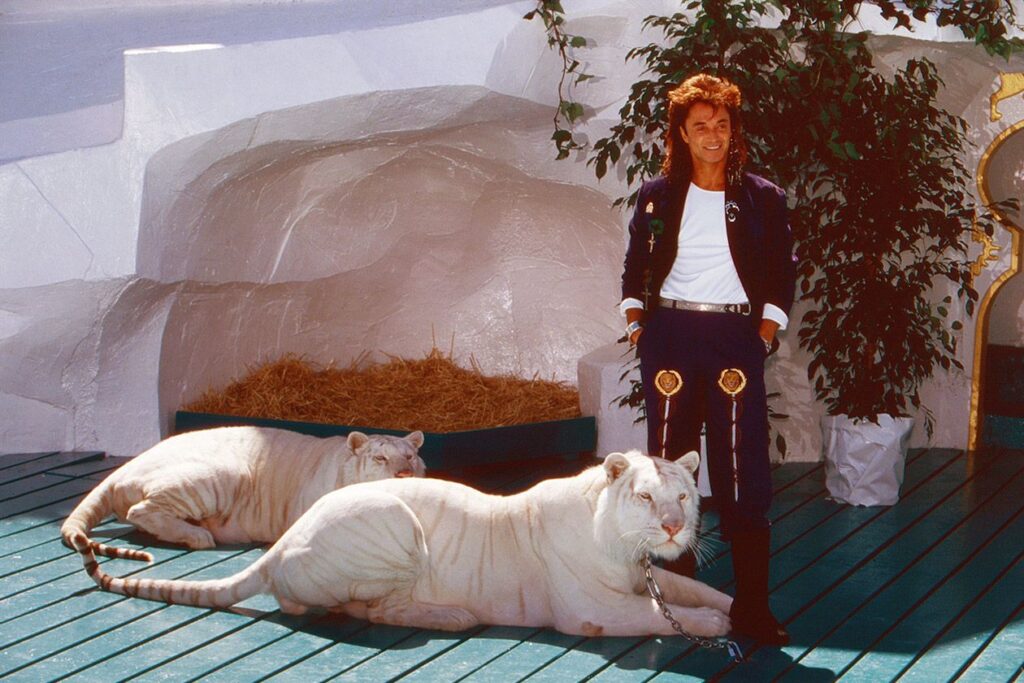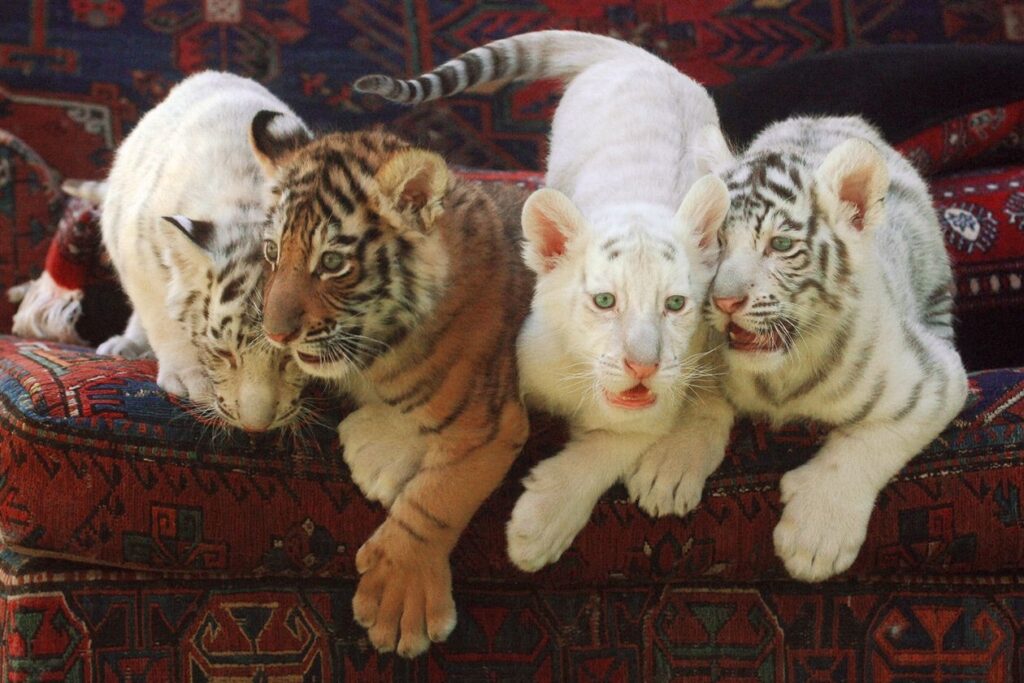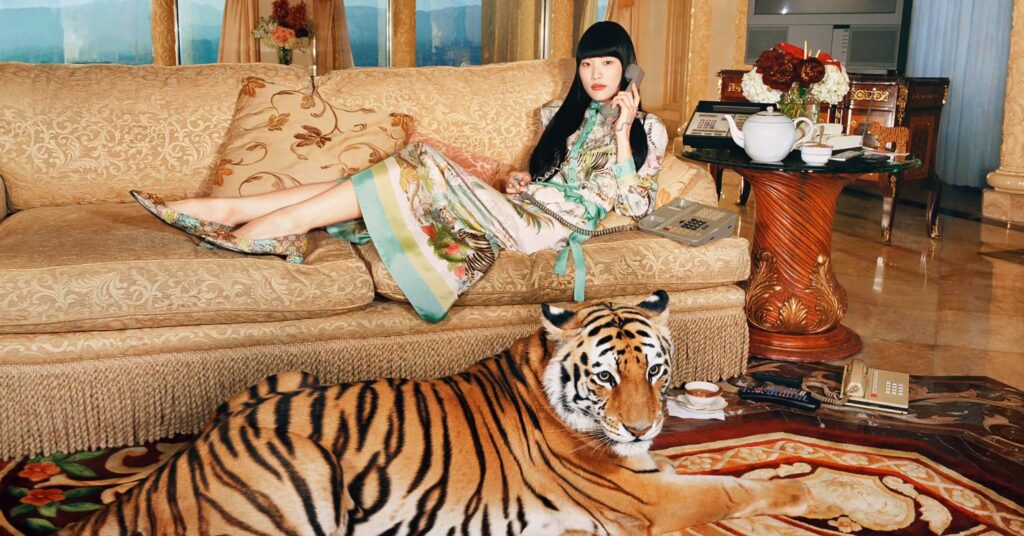Gucci has made significant strides in recent years for the planet and its inhabitants. It went fur-free in 2017, joining a growing list of luxury fashion brands in eschewing animal pelts. In 2018, it launched the Gucci Equilibrium, a platform for social change and climate action. Since then, the company’s supply chain has been carbon neutral, reducing emissions by switching to renewable energy and by investing millions into projects to offset its negative carbon footprint, such as initiatives that fight deforestation. According to its 2020 impact report, the company decreased its greenhouse gas emissions by 47 percent and its overall environmental footprint by 44 percent.
In 2020, Gucci launched its first-ever sustainable collection, Off The Grid. In line with the brand’s goal of circular production, the collection features recycled and organic materials, including a 100 percent regenerated nylon made from pre-and post-consumer waste. That same year, Gucci joined The Lion’s Share Fund, an initiative that supports wildlife conservation. But, with its latest collection—Gucci Tiger—the fashion giant is bringing its support of wild animals and the natural world to a screeching halt.
Gucci: Animal friend or foe?
When Italian fashion designer Alessandro Michele took over the helm of Gucci in 2015 as creative director, he completely reimagined the face of the luxury fashion powerhouse. Gone were the minimalistic designs of Michele’s predecessors, Tom Ford and Frida Giannini. In their place, Michele ushered in a new era of collections brimming with an alluring, maximalist aesthetic, gender fluidity, vibrant color schemes, and Renaissance-esque elements—cue Jared Leto’s 2019 Met Gala look.
In a nod to his father, who deeply loved nature, Michele’s animal and nature imagery are widely apparent across the century-old brand’s collections. Animal motifs arise in the form of dogs, owls, snakes, bees, leopards, birds, and the like. So, given that 2022 is the Year of the Tiger, according to the Chinese Zodiac, it should come as no surprise that the majestic big cat is front-and-center in Gucci’s latest collection, as it is with other designers like Balenciaga and Marc Jacobs
The Gucci Tiger collection’s print is a reinterpretation of artist Vittorio Accornero’s 1960s archival print. (Accornero created the fashion giant’s signature Flora design.) The ready-to-wear, 80-piece collection prioritizes sustainability. It features Gucci’s self-produced, vegan leather material, Demetra, which is composed of viscose and bio-based polyurethane. And the collection even sports the brand’s first eco-conscious watch, which has a Demetra strap and comes in a recycled stainless steel case.
The illustrations of the powerful feline intertwined with floral print are striking, even if the high-fashion price tag makes it accessible to few. But it’s hard to ignore Gucci Tiger’s glaring fallacy. Gucci Tiger’s campaign video plays like a fever dream: real-life tigers roam an opulent hotel as models, dressed to the nines in the new collection, are shown dining on pastries and sipping tea. For all of its sustainability efforts and purported investments in biodiversity, this blatant exploitation of one of nature’s most magnificent, and endangered, creatures for marketing glitz makes Gucci appear to be truly ignorant about the causes it supposedly supports.

No, wild animals are not pets… or props
It should go without saying, but tigers are supposed to be in the wild, their natural habitat, and not on a film set. Gucci’s use of them totally eradicates its sentiment of care for the natural world.
“In these ads, tigers are just another luxury item, no different from a fancy chair. Just like expensive clothes and vacations, tigers are another ‘thing’ to acquire,” explained Liz Cabrera Holtz, Wildlife Campaign Manager for animal welfare group World Animal Protection.
“There’s no recognition that tigers are wild animals and living beings,” she added. “The ads encourage people to view possessing captive tigers as the ultimate status symbol, fueling the cruel wildlife trade.”
Gucci did not respond to our request for comment, but on Instagram, the company notes that animal welfare group American Humane “verified that no animals were harmed” in the making of the Gucci Tiger campaign. It adds: “Tigers were filmed in a separate safe environment complying to Gucci’s policies and then featured within the campaign.” LIVEKINDLY reached out to American Humane for further comment but we are yet to receive a response.
But here’s the thing, a “safe” environment for exotic animals on a film set just doesn’t exist. Keeping and manipulating captive wild animals in these settings only puts people—as well as the animal itself—at risk of injury and even death. One of the more notorious examples occurred during the making of Roar, which saw the cast and crew suffer maulings, bites, and other injuries by captive wild animals on the set. The 1981 film, which stars Tippi Hedren and Melanie Griffith, is about a naturalist who lives on an African nature preserve with a myriad of big cats.
Or consider the mauling of the late Roy Horn, one-half of the magician duo Siegfried & Roy, by a tiger during a performance at The Mirage Hotel & Casino in Las Vegas in 2003. Horn—who passed away last year at the age of 75 due to complications from the coronavirus—was well-versed in handling big cats but was simply no match for the 400-pound tiger.
In the words of comedian Chris Rock: “The tiger bit the man in the head, and everybody’s mad at the tiger. Talking ‘bout the tiger went crazy. That tiger ain’t go crazy; that tiger went tiger.” (For the record, Horn later stated that the tiger, who had latched onto his neck and dragged him off stage, was merely trying to help him after he suffered a stroke.)
“Really there’s no humane way to do a photo shoot with a captive tiger, or a captive wild animal for that matter,” says Lindsay Oliver, executive director for World Animal Protection U.S. “There’s a lot of control and manipulation that goes on for those animals. It’s very stressful, it’s cruel, and it’s usually a dangerous situation as well.”

Here’s the problem with wild animals in captivity
The life of a tiger film star may sound glorious, but Netflix’s controversial 2020 docuseries Tiger King proved it’s anything but. Although Tiger King did lose sight of the animal welfare issues prevalent throughout the show—a true-crime series focused on wild animal keeper Joe Exotic and his plot to kill animal rights activist Carol Baskin—it did shine a spotlight on the issue of wild animals in captivity, especially that of big cat-breeding.
According to World Animal Protection, with only an estimated 3,900 tigers remaining in the wild, there are now more tigers living in captivity in the U.S. These captive big cats are kept in roadside zoos, which aren’t accredited by the Association of Zoos and Aquariums, such as the one featured on Tiger King, circuses, and other attractions that masquerade as tiger rescues and sanctuaries. A simple Google search for “rent tiger” returns a lengthy list of companies that rent out captive wild animals like elephants, lions, and giraffes. One reads: “Hire skilled animal trainers and rent exotic animals for a film or video production, a party, or any kind of event.”
These “attractions”—mere profit generators at the expense of animals—may be cited for violations of the American Welfare Act due to concerns like inadequate veterinary care, improper cages, and a lack of access to food and clean water. But ultimately, due to lax state and federal laws, as well as the careless enforcement by oversight agencies, many are able to continue operating.
Unlike these for-profit establishments, whose treatment of animals is antithetical to conservation, reputable sanctuaries prioritize the safety and wellbeing of their animals and will not typically buy, sell, or trade them. The primary goal is to rehabilitate the animals or offer a place of refuge if they are unable to return to the wild.
Oversight by a third-party organization or not, keeping wild animals captive for the sake of entertainment is inherently cruel. After all, they have natural instincts and behaviors that life in captivity simply cannot accommodate. Despite this, they are often forced to do tricks on cue until they become too old or sick to perform.
In captivity, big cats like tigers usually suffer from a lack of adequate physical activity, poor care, and unnatural diets. Frustration and unnatural stress can also result in zoochosis, symptoms of which include head-bobbing, excessive licking, or pacing.

An even bigger issue: The illegal wildlife trade
Gucci’s use of captive tigers glorifies keeping exotic animals as pets, which subsequently fuels the demand for the illegal wildlife trade.
According to the U.S. Fish and Wildlife Service, the illegal wildlife trade is a multibillion-dollar industry that sees wild animals traded for food or medicine, for their skins, or as pets.
“Countless species are exploited by the trade in wild animals for use as pets and are now under pressure in the wild. African grey parrots, otters, ball pythons are just a few. Some of these animals, like ball pythons, are even sold in major pet store chains like PetSmart,” explains Cabrera. “Bred in captivity in cruel mills or captured from their natural habitats, wild animals from snakes to turtles to monkeys to tigers are suffering.”
A 2019 study found that nearly 1,000 species are now classified as at risk of extinction by the International Union for Conservation of Nature due to the illegal wildlife trade, including pangolins and rhinos.
Social media influencers and big-name celebrities are also contributing to the appeal of keeping wild animals as pets. They’re also contributing to the animals’ exploitation. Influencer David Dobrik (who was “canceled” last year amid misconduct allegations) had a segment on his YouTube channel in which he surprised his friend with animals, including a baby bear and a monkey—all for content ratings.
In 2013, singer Justin Bieber made headlines after his pet capuchin monkey was confiscated by German customs officials. Former professional boxer Mike Tyson owned several tigers, one of whom he sold after 16 years. “She got too old and I had to get rid of her when her eyes and her head got bad. Oh, and she ripped somebody’s arm off,” he said in an interview for GQ.
Hey, Gucci: Ever heard of CGI?
Gucci may be a leader in fashion—disrupting gender categories and fostering sustainability—but with its latest collection, it’s certainly proving it’s falling short of keeping up with the changing times. Using tigers for a clothing advert is not only unethical, it’s also wholly unnecessary.
Innovation is now advancing archaic norms—you know, like making handbags out of alligators and using real, live tigers in ad campaigns.
Case in point: 2016’s The Jungle Book, a remake of Disney’s 1967 animated film of the same name. From the black panther Bagheera to the giant snake Kaa down to the harrowing buffalo stampede, the film created all of its animals using computer-generated imagery (CGI). And if the film’s expansive award wins (Academy Award for Best Visual Effects, BAFTA Awards for Best Special Visual Effects, etc.) are anything to go by … the visuals were nothing short of stellar.
Movies like 2011’s Rise of the Planet of the Apes and 2019’s The Lion King all feature creatures generated via animation software realistic enough to make audiences swoon. Even director James Cameron, with his obsession with authenticity, employed CGI to create entirely different worlds in the 2009 sci-fi/action film Avatar. If millions of movie tickets around the world are any indication, I’d say it’s convincing enough technology to employ in a one-off marketing campaign to sell designer luxury wear.
Animal welfare issues aside, these advancements in technology are proving there’s absolutely no need to use captive exotic animals for the sake of entertainment—or for any reason. Period. Exotic animals like tigers have no place in the media (or petting zoos, or circuses). They belong in the wild. To Gucci and Alessandro Michele: If you really care about the natural world and its inhabitants, help keep human evolution moving forward, not backward. Foster a House in which your revolutionary creative prowess and iconic fashions don’t contribute to the misery of innocent animals. You certainly have the funds to employ the use of CGI. So put your money where your mouth is. And leave animals alone.
The views expressed in opinion pieces are those of the author(s) and do not represent the policy or position of LIVEKINDLY.


